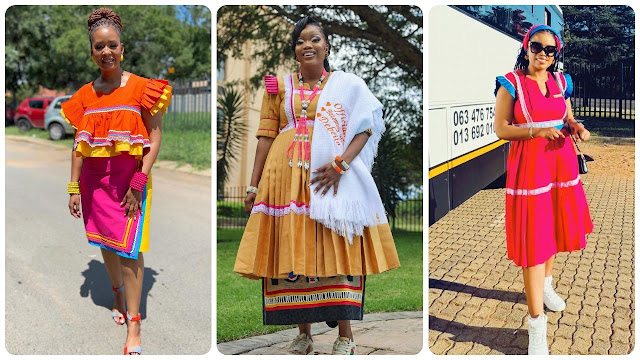Colorful and Proud: Explore the Magic of Sepedi Designs
Colorful and Proud: Explore the Magic of Sepedi Designs
Sepedi traditional wear is one of South Africa’s most vibrant and culturally expressive fashion styles. Known for its bold colors, striking patterns, and symbolic detailing, Sepedi fashion, especially for women, is more than just clothing—it is a proud representation of heritage, identity, and celebration. Whether it’s worn at weddings, cultural events, or modern occasions, Sepedi dresses light up every space with color and purpose.
In this article, we take a closer look at the beauty, meaning, and evolution of Sepedi dress designs, and how they continue to influence and inspire modern fashion lovers across the continent and beyond.
A Heritage of Color and Pride
The Sepedi people, also known as the Northern Sotho, are known for their deep-rooted customs and expressive traditional attire. The most iconic feature of Sepedi dresses is their vibrant use of color, particularly in shades of red, blue, yellow, green, and white. These bright colors are not only visually striking—they carry cultural symbolism linked to celebration, family, and joy.
Typically, Sepedi women's attire includes:
A bold, flared skirt (often pleated or layered)
A fitted bodice or blouse
Decorative ribbons or stripes in contrasting colors
Headwraps (duku) and traditional beaded accessories
The entire outfit comes together as a powerful visual representation of cultural pride.
Traditional Looks with a Modern Spin
While traditional Sepedi attire remains timeless, fashion designers and wearers are adding modern flair to these looks. The combination of classic patterns with contemporary tailoring allows Sepedi fashion to stay rooted in tradition while appealing to the modern eye.
Here are a few ways Sepedi designs are evolving:
1. Modern Cuts and Silhouettes
Instead of just long traditional skirts, Sepedi designs now include mermaid dresses, pencil skirts, and peplum tops, allowing women to choose shapes that flatter their personal style.
2. Wedding Wear for the Modern Makoti
Today’s Sepedi brides (makoti) shine in full custom gowns made from traditional fabric and ribbon combinations. These wedding dresses often feature layered tulle, corset tops, or modern lace elements, blending heritage with glamour.
3. Everyday Sepedi Looks
Sepedi fashion is no longer limited to cultural events. Many women are embracing casual or semi-formal Sepedi-inspired pieces like midi dresses, jumpsuits, or two-piece sets that they can wear to church, work, or even parties.
Cultural Significance of Design Elements
The use of colored ribbon detailing in Sepedi dresses isn't just for decoration—it’s symbolic. Each color can represent a value or a celebration:
Red often signifies strength and vitality
Blue reflects peace and calmness
Yellow stands for joy and energy
Green symbolizes life and growth
White is commonly associated with purity and celebration
When these colors are combined in one outfit, the result is a vibrant, eye-catching celebration of life and tradition.
Accessories That Complete the Sepedi Look
No Sepedi outfit is complete without the perfect accessories. These often include:
Colorful beadwork in necklaces, earrings, and bracelets
Handbags or shoes made with matching fabric
Decorative sashes or aprons
Stylish headwraps tied in symbolic styles
Accessories play a key role in elevating the outfit while adding a personal touch to every ensemble.
Sepedi Style for All Generations
Sepedi fashion is proudly worn by women of all ages, from young girls to grandmothers. It connects families across generations, especially during important cultural events, weddings, and national celebrations like Heritage Day. The designs are often passed down, reworked, and reimagined—ensuring that the spirit of Sepedi lives on in every stitch.
Conclusion: A Culture That Shines Through Fashion
Colorful and proud, Sepedi designs are more than just traditional wear—they are living, evolving expressions of identity, pride, and unity. As fashion continues to change, the beauty of Sepedi lies in its ability to adapt while still holding onto its deep cultural roots.
Whether you're wearing it for a wedding, cultural event, or simply to honor your heritage, a Sepedi dress is always a powerful statement of beauty and belonging.




















.jpg)

.jpg)
